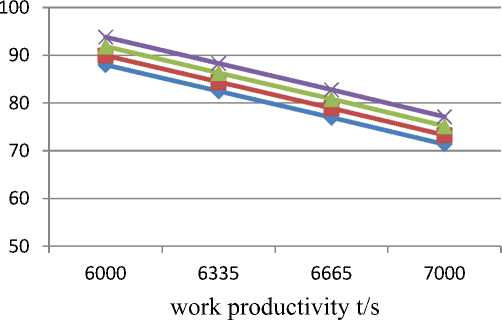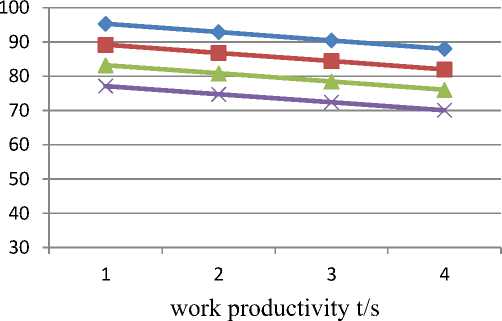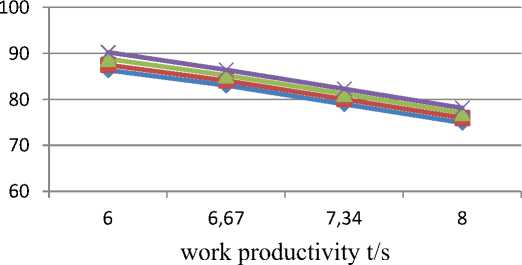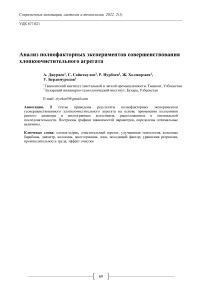Analysis of full-factorial experiments on improving the cotton gin
Автор: A. Djuraev, S. Sayitqulov, R. Nurboev, J. Xolmirzaev, U. Berdimurodov
Журнал: Современные инновации, системы и технологии.
Рубрика: Прикладные вопросы и задачи применения систем и технологий
Статья в выпуске: 2 (1), 2022 года.
Бесплатный доступ
The article presents the results of full-factorial experiments of an improved cotton-cleaning unit based on the use of grates of different diameters and multifaceted grates located in the optimal sequence. Graphs of dependences of parameters are constructed, optimal values are determined.
Raw cotton, cleaning aggregate, enhanced technology, peg drum, diameter grates, multi-sided, sequence, zones receiver, outgoing factors, regression equations, work productivity, cleaning effect
Короткий адрес: https://sciup.org/14121919
IDR: 14121919 | УДК: 677.021 | DOI: 10.47813/2782-2818-2022-2-1-69-75
Текст статьи Analysis of full-factorial experiments on improving the cotton gin
So far, the factors affecting the amount of fine and coarse contaminants in the process of cleaning raw cotton have been studied. In particular, the frequency of rotation, parameters of the peg drum, grates, saw drum and others studied [1,2]. In the world market, the demand for maximum preservation of the natural physical and mechanical properties of fiber is growing.
World standardization pays special attention to the appearance of the fiber and the amount of impurities in it, so it is important to increase the efficiency of cleaning cotton from small and large contaminants. At the same time, it should be noted that the disadvantages of the existing design of the machine for cleaning cotton from small and large contaminants (CCC) are that it separates fine wastes and combines with large contaminants separated from the cotton. In addition, the CCC cotton ginning machine does not have a sufficiently high efficiency in cleaning both fine and coarse waste.
Taking into account the above, the experimental version of the improved design of the working bodies was carried out, taking into account the recommended parameters as a result of theoretical studies of the machine for cleaning cotton from small and large contaminants.
The characteristics of the modernized cleaning unit according to the proposed technology were considered [3,4].
2. Materials and methods
The essence of the design lies in the fact that a combined cotton cleaner containing a cotton cleaner from small litter peg drums and a mesh under them alternating with them a cotton cleaner from large litter containing serrated drums and with a grate under them and a fixed brush, while the diameters of the pegs of each subsequent drum by 10% more than the diameters of the pins of the previous drum, the grates of the coarse litter cleaner are made multifaceted, and the grates of the first coarse cleaning zone are made hexagonal, the second zone are seven-sided and the third zone are octagonal. At the beginning of cleaning, the raw cotton will be less loosened, and therefore it is important to effectively open the cotton by making the first drum with the smallest diameter. In the final cleaning zone, the cotton will be more loosened, and therefore, for its efficient transportation, the diameter of the drum pegs is made the largest. Accordingly, in the first zone of cleaning cotton from large litter, the grates are made hexagonal, allowing the loosening of cotton into individual bats, and in the third zone, the grates are made octahedral. At the same time, the deceleration of the cotton flyers is reduced to the maximum when they interact with the octagonal grate. The combined cotton cleaner allows efficient separation of litter, while small and large litter impurities are discharged separately through the appropriate screw conveyors.
Typically, experimental or theoretical research consists of determining the optimal values of the parameters that affect the process under study. Therefore, it is important to study the process in depth and make the right choice of influencing parameters.
In experimental studies, often important characteristics of technological processes consist of random quantities, the distribution of which is close to the normal law. Therefore, in order to reduce the number of experimental studies, it is advisable to use the method of mathematical planning of experiments [5,6].
The experiments were carried out in one section of the modernized ginning unit for cleaning zones of small and large contaminants [7].
Based on the above, we select the following incoming factors when conducting full-factor experiments to study the process under study: Х 1 – work productivity; Х 2 - diameter of pegs mm; Х 3 – the number of sides of the grates.
Table 1. The values of the selected unwanted factors are given.
|
Factor name |
Coded icon |
The rea -1 |
l value of t 0 |
e factor +1 |
Factor change interval |
|
Work productivity |
Х 1 |
6000 |
6500 |
7000 |
500 |
|
The diameter of the pegs |
Х 2 |
8 |
10 |
12 |
2 |
|
The number of sides of the grates |
Х 3 |
6 |
7 |
8 |
1 |
Using the existing methodology, the following regression equation was generated [7-10].
Y = 82,6375 + 2,9 xx - 9,035 x 2 + 0,70125 x 3 + 0,00625 xx -- 0,01875 xx - 0,06875 x2x3
The mathematical calculation of the conformity of the obtained equation (1) showed that the model is in good agreement with the experimental results. The essence of the regression coefficients in the models characterizes the contribution of the factor to the value of the output parameter of the corresponding factor in the transition from the base level to the bottom or top. The larger the regression coefficient, the higher the efficiency of this factor, i.e., the stronger the effect of the factor on the output parameter. Thus, the regression coefficients are sorted by value in the models due to the effect of factors.
Let us consider the effect of the incoming factors on the factor under study, i.e., on the cleaning efficiency. The analysis of the regression equations shows the main effects on the cleaning efficiency: Work productivity ( х 1 ), Peg diameter ( х 2 ), Number of grates edges ( х 3 ) and the interaction of factors ( х 1 х 3 , х 2 х 3 , х 1 х 2 х 3 ). To investigate this connection, a numerical calculation of the curve at different values of the key factors according to the regression equation was performed.
After processing, the calculation results were presented in the form of graphs for raw cotton. (Figure 1) the purification efficiency correlation is given, four connection lines my = y (x) are given. The first connection corresponds to the minimum value of the line, the values in the second and third intervals, and the fourth to the maximum value of the factors X 2 and X 3 .
3. Results and discussion
In figure 1, the first contact line decreases when the productivity increases from 6000 kg / h to 7000 kg / h, i.e., when the base factor changes х 2 = 8 mm, х 3 = 6, from 87.99% to 71.35%, and at the maximum value, i.e., at х 2 = 12 mm, х 3 = 8, it decreased from 93.82% to 77.12%. On the second and third connecting lines, it decreased from 89.94% to 73.28% and from 91.86% to 75.19%, respectively.
Figure 2 shows the effect of peg diameter on cleaning efficiency. When the curve diameter of the piles decreases from 12 mm to 8 mm, the cleaning efficiency on the first contact line decreases from 95.32% to 87.99% at the minimum values of the main factors х 1 = 6000 kg /h, х 3 = 6, and at the maximum value, i.e. х 1 = 7000 kg / h, decreased from 77.12% to 70.05% at х 3 = 12. On the second and third curves, it decreased from 83.22% to 76.06% and from 89.22% to 81.98%, respectively.


Figure 1. Impact of work productivity on cleaning efficiency.
Figure 2 . Influence of pegs diameter on cleaning efficiency.

Figure 3 shows the effect of the number of grates edges on the cleaning efficiency. The resulting curves are characterized by a change in the downward regularity of the cleaning efficiency depending on the data of х 1 and х 2 when the number of grate edges increases from 6 to 8: х 1 = 6000 kg / h; at х 3 = 6 edges, the cleaning efficiency decreases from 86.4% to 74.90%, at the second connection line х 1 = 6335 kg / h; at х 1 = 6.67mm it decreased from 75.98% to 87.09%, in the third and fourth connecting lines from 88.80% to 77.04%, and from 90.25% to 78.12%.
Figure 3 . The effect of the number of grate edges on the cleaning efficiency.
All the parameters mentioned above and their ratio affect the cleaning efficiency. The parameters of the incoming factors should be selected in such a way that they work to improve the cleaning efficiency.
4. Conclusion
Analysis of the results obtained in a full-factor experiment allows us to recommend the following values of the selected key factors:
-
• work productivity - 7000 kg / hour;
-
• diameter of pegs - 8 mm;
-
• the number of sides of the grates at the given values of the factors, the cleaning efficiency was ensured to be higher than 90.25%.


